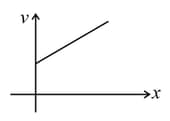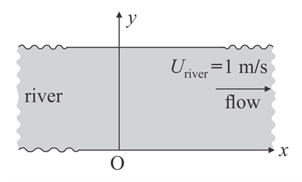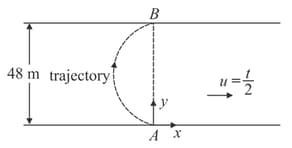A particle moves along -axis in a positive direction. Its acceleration is given as , where denotes the -coordinate of particle, and are positive constants. For velocity-position graph of particle to be of type as shown in figure, find the value of speed (in ) of particle at . Take and



Important Questions on Kinematics
A man can swim in still water with a speed of , and -axes are drawn along and normal to the bank of river flowing to right with a speed of . The man starts swimming from origin at second. Assume the size of the man to be negligible. Find the equation of locus of all the possible points where the man can reach at .

Two swimmers , one located on one side and other on the another side of a river, are situated at a distance from each other. The line joining them is making an angle with the direction perpendicular to the flow. The speed of each swimmer with respect to still water is and speed of river flow is . Both start swimming at the same time in the direction parallel to line towards each other and they keep on swimming in the same direction. Then,
(a) Find the time after which they meet.
(b) Find the speed of river so that the path of the two swimmers with respect to the ground becomes perpendicular to each other.
Two particles start simultaneously from the same point and move along two straight lines making an angle with each other. One move with uniform velocity and the other with constant acceleration and initial velocity zero.
(a) Find the least relative velocity of one with respect to the other.
(b) At the same time, find the distance between the two particles.
(a) if the direction of the wind is along one side of the square,
(b) if the direction of the wind is along one of the diagonals of the square.
A man starts swimming at time from point on the ground and he wants to reach the point directly opposite to the point . His velocity in still water is and the width of river is . The river flowing with velocity varies with time (in seconds) as, . He always tries to swim in a particular fixed direction with river flow. Find the (given, ),

(a) direction (with line ) in which he should make a stroke and the time taken by the man to cross the river.
(b) the trajectory of the path.
A child in danger of drowning in a river is being carried downstream by a current that flows uniformly at a speed of . The child is from shore and downstream of a helipad when the rescue helicopter sets out and the helicopter follows the same direction throughout the motion. The helicopter proceeds at its maximum speed of with respect to air while air is blowing with a velocity of perpendicular to the river with water flowing velocity as shown. Then,
(i) heading at what angle with the shore should the helicopter take off?
(ii) calculate the time taken by the helicopter to reach the child.

